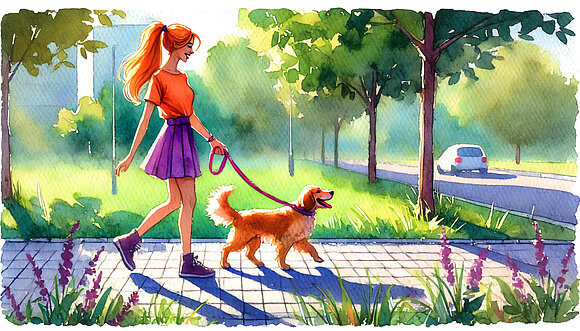Watch out for hot paws: When is the ground too hot to walk on?

Why is the hot floor dangerous?
Dogs walk barefoot, which means that their sensitive paws are in direct contact with the ground. While our human feet are protected by shoes, dogs are exposed to extreme temperatures without protection. Hot surfaces such as asphalt, sand or concrete can reach temperatures far above the air temperature. This can lead to painful burns and blisters.
The 7-second rule
A simple method to determine whether the ground is too hot is the 7-second rule. Place the back of your hand on the floor and hold it there for seven seconds. If it's uncomfortable or too hot for you to leave your hand there for that long, the floor is too hot for your dog's paws too.
What temperature is too hot?
In general, it can be said that surfaces become dangerous for dogs from a temperature of around 50 degrees Celsius. But even at lower temperatures, the floor can be hot enough to be uncomfortable for your dog.
| Air temperature (°C) | Asphalt temperature (°C) |
|---|---|
| 25 | 52 |
| 30 | 57 |
| 35 | 62 |
This table shows that even when the air temperature is a pleasant 25 degrees, the asphalt can heat up to a dangerous 52 degrees.
Signs of burnt paws
It is important to know the signs of burnt paws so that you can help your dog immediately. Look out for the following symptoms:
- Limping or unusual walking
- Twitching of the paws or constant lifting of a paw
- Redness or blistering on the paw pads
- Excessive licking or chewing of the paws
If you notice any of these signs, see a vet immediately.
Tips to protect the paws
Avoid the hottest times of day
Try to reschedule walks for early morning or late evening when temperatures are lower and the ground has cooled.
Choose shady paths
If possible, choose shaded paths or grassy areas that retain less heat than asphalt or concrete.
Paw protection
There are special dog shoes or paw waxes that can protect your dog's paws from the heat. Slowly get your dog used to wearing these protective measures.
Frequent breaks
Take regular breaks in shady places during the walk and give your dog the opportunity to rest on cooler surfaces.
Check paws regularly
Check your dog's paws after every walk for signs of injury or burns and treat them immediately if necessary.
Conclusion
Summer is a wonderful time to be active outdoors, but always remember that the heat can pose a risk to your dog's sensitive paws. With the right precautions, you can make sure your four-legged friend stays safe and happy on hot days. Use the 7-second rule, pay attention to the temperature and choose shady paths - so nothing stands in the way of a carefree walk!